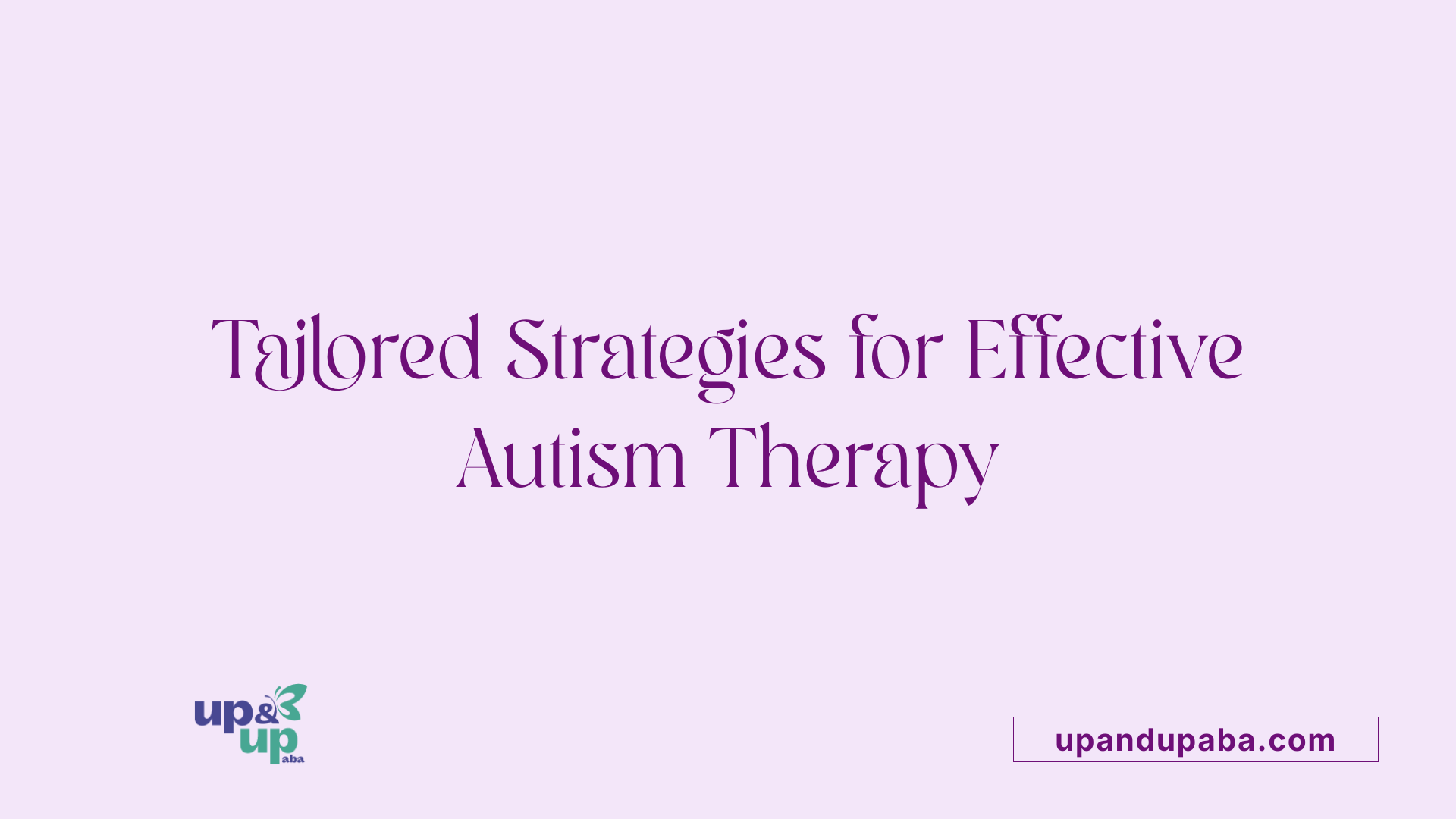Cognitive Behavioral Therapy in Autism
Unlocking Potential: The Role of CBT in Autism Spectrum Disorder

Understanding the Foundations of CBT in Autism
Cognitive Behavioral Therapy (CBT) has emerged as a vital, evidence-based psychological intervention tailored to address the complex challenges faced by individuals with autism spectrum disorder (ASD). Rooted in the principle that thoughts, feelings, and behaviors are interconnected, CBT provides structured techniques to help Autistic individuals develop coping strategies, enhance social skills, and manage emotional difficulties, particularly anxiety and depression. Its adaptability and empirical support make it a cornerstone in autism treatment plans, especially for those with higher functioning autism or co-occurring conditions.
Principles and Mechanics of CBT in Autism

What is cognitive behavioral therapy (CBT) for autism and how does it work?
Cognitive behavioral therapy (CBT) for autism is a short-term, structured form of psychotherapy designed to help children on the autism spectrum, especially those with co-occurring mental health conditions like anxiety or depression. The goal of CBT is to help these children develop coping skills so they can better manage their emotions, thoughts, and behaviors.
CBT focuses on the strong connection between thoughts, feelings, and actions. By working with a trained therapist, children learn to recognize how their thoughts influence their emotions and reactions. This awareness allows them to practice altering unhelpful or negative thought patterns, which can lead to improved emotional regulation and social interactions.
The therapy is usually tailored to the individual, adjusting to their cognitive strengths and challenges. It involves understanding triggers for anxiety or problematic behaviors and gradually developing healthier responses. For example, children might learn relaxation techniques, problem-solving skills, and ways to face fears or social situations more confidently.
Parents often participate in the process, helping reinforce skills outside of sessions, ensuring that acquired strategies are applied across different settings. Though CBT does not cure autism, it serves as a valuable tool to help children manage secondary issues like anxiety, depression, and social difficulties, ultimately improving their daily functioning and quality of life.
How CBT works with individuals with ASD
The success of CBT with individuals with ASD depends on its customization. Traditional CBT includes clear, concrete instructions and repetitive practice, which align well with many children on the spectrum. Modifications often involve making the therapy more visual, engaging, and predictable, helping children follow along and stay motivated.
During sessions, children might participate in activities like role-playing, journaling, or visual exercises that reinforce learning. The therapist guides children through understanding emotional responses and developing strategies to respond differently in social or stressful situations.
Adults supporting the child are encouraged to be involved, assisting with skills generalization and consistency. Over time, children learn to identify thoughts that lead to anxiety or inappropriate behaviors and apply coping strategies independently.
Research suggests that with proper adaptation, many children with ASD benefit from CBT, showing improvements in anxiety levels, social understanding, and emotional resilience.
Core components and structure of CBT
CBT typically comprises two interconnected parts:
| Component | Description | Example Techniques |
|---|---|---|
| Cognitive | Helping children recognize and modify unhelpful or negative thoughts | Cognitive restructuring, guided discovery |
| Behavioral | Changing reactions and behaviors to better handle social or emotional challenges | Exposure exercises, activity scheduling, relaxation techniques |
The process usually involves several phases:
- Psychoeducation about emotions and behaviors
- Identifying anxiety triggers or problematic thoughts
- Developing coping skills and strategies
- Practicing these skills through real-life exercises
- Reviewing progress and adjusting goals
Sessions often last between 30 to 60 minutes, occurring weekly over several months. The tailored approach allows children with ASD to build skills gradually while respecting their individual learning styles.
Goals, Benefits, and Tailored Strategies in CBT
What are the benefits and goals of CBT for individuals with autism?
Cognitive-behavioral therapy (CBT) for individuals with autism aims to address secondary issues such as anxiety, depression, and social skills deficits by helping them recognize and modify unhelpful thoughts, feelings, and behaviors. It is tailored to meet individual strengths and needs, often incorporating visual aids, social stories, and repetition to suit the concrete thinking styles common in autism.
The primary goals include reducing anxiety and maladaptive behaviors, improving social understanding and emotional recognition, and increasing the ability to cope with stressful or challenging situations. CBT also emphasizes skill-building in areas like emotion regulation, social interactions, and adaptive coping strategies.
Involving families or groups can be beneficial for enhancing generalization of skills and providing additional support. Overall, the therapy seeks to empower autistic individuals to achieve greater independence, participate more fully in social environments, and improve their emotional well-being.
This personalized approach helps address the unique cognitive and behavioral profiles of each individual, making CBT a versatile and effective treatment option for many on the autism spectrum.
Enhancing Social and Emotional Skills through CBT
Can CBT be used to improve social skills and manage anxiety in autistic individuals?
Yes, CBT is an effective approach for enhancing social abilities and reducing anxiety among individuals with autism spectrum disorder (ASD). When customized to fit their specific needs, CBT techniques have shown significant results.
Research from various randomized controlled trials indicates that children and young adults with ASD experience notable improvements in social functioning after participating in modified CBT programs. These programs often include behavioral experiments, parent coaching, and collaborations with schools to create supportive environments.
Meta-analyses reinforce these findings, demonstrating that CBT can lead to meaningful improvements in social skills, such as understanding social cues and engaging with peers. Additionally, CBT helps clients develop coping strategies to manage anxiety, often a prominent challenge in ASD.
One particular strength of CBT is its adaptability. Therapists can modify traditional methods—making sessions more visual, repetitive, and concrete—aligning with the individual's strengths and weaknesses. For instance, role-playing social scenarios or using visual aids can help individuals better grasp social rules and emotional regulation.
In summary, tailored CBT programs equip autistic individuals with practical skills to navigate social interactions and cope with anxiety, improving their overall quality of life.
Adapting CBT to the Needs of Autistic Clients
 Cognitive Behavioral Therapy (CBT) can be highly effective for individuals with autism spectrum disorder (ASD) when appropriately tailored to their specific needs. Modifications focus primarily on addressing sensory sensitivities, communication challenges, and differences in social understanding.
Cognitive Behavioral Therapy (CBT) can be highly effective for individuals with autism spectrum disorder (ASD) when appropriately tailored to their specific needs. Modifications focus primarily on addressing sensory sensitivities, communication challenges, and differences in social understanding.
One key adaptation involves making the therapy more visual, concrete, and repetitive. For example, therapists might use visual aids, social stories, or diagrams to clarify social cues and emotional recognition. Techniques such as role-playing and activity scheduling are also adjusted to suit the learning style of the individual, helping them better grasp social rules and emotional concepts.
Since many autistic individuals experience sensory overwhelm, therapy sessions may incorporate sensory breaks or environment modifications to ensure comfort and focus. Communication differences, including difficulties understanding abstract language, are addressed by simplifying explanations and using more direct language.
Approaches for teaching social cues and emotional recognition are central to adapted CBT. Clinicians might use video modeling, social skills groups, and guided discovery to help clients interpret facial expressions, body language, and situational cues. Given the common challenge of 'mindblindness,' or difficulty understanding others’ mental states, therapy emphasizes perspective-taking exercises, often breaking down emotions into manageable, identifiable components.
Leveraging strengths is another crucial aspect. Many autistic individuals possess remarkable attention to detail, systemizing skills, or vivid interests. Therapists incorporate these strengths into therapy—such as analyzing systems or interests—while working on broader social and emotional skills.
Furthermore, individualization remains essential. Adapted CBT considers the client’s language abilities, cognitive level, and specific interests to design engaging, effective interventions. Overall, these modifications aim to improve social functioning, emotional regulation, and communication, increasing the therapy’s relevance and success for autistic clients.
| Modification Area | Techniques Used | Purpose |
|---|---|---|
| Sensory and environment | Sensory breaks, environment adjustments | Increase comfort and focus |
| Visual supports | Social stories, visual aids | Clarify social cues and concepts |
| Communication | Simplified language, concrete explanations | Improve understanding |
| Teaching social skills | Video modeling, role play, social stories | Enhance recognition of social cues |
| Cognitive strengths | System analysis, interests-based activities | Leverage client strengths |
| Emotional recognition | Perspective-taking exercises, emotion breakdown | Build social-emotional understanding |
Research Evidence Supporting CBT Effectiveness in Autism

What does scientific research say about the effectiveness of CBT for autism?
Numerous studies and analyses have assessed how well cognitive behavioral therapy (CBT) works for individuals with autism spectrum disorder (ASD). A comprehensive meta-analysis, including 45 randomized controlled trials and 6 quasi-RCTs with nearly 2,500 children and adolescents, found that CBT can significantly improve core ASD symptoms and social-emotional challenges. The improvements were especially evident through informant reports—such as input from parents, teachers, and clinicians—and through task-based assessments.
CBT has consistently shown to help decrease anxiety, which is prevalent among children and teens on the spectrum. Large effect sizes across multiple studies indicate robust benefits in reducing anxiety symptoms. Additionally, research demonstrates notable enhancements in social skills, measured by tools like the Social Responsiveness Scale (SRS). These gains are particularly relevant for higher-functioning individuals capable of engaging with cognitive components of therapy.
However, the same studies also show that self-reported outcomes from children or adolescents tend to reflect less improvement. This discrepancy suggests that while observable behaviors and external assessments improve, internal perceptions may vary.
The impact of CBT extends beyond symptom reduction. It has been linked to better emotional regulation and increased social understanding. Although the evidence base is strong—especially for anxiety and social skills—certain limitations remain. Many studies focus on clinical settings, and data about long-term maintenance of the improvements are still emerging.
In summary, scientific findings underscore that CBT is a validated approach with proven benefits for reducing ASD symptoms, improving social engagement, and alleviating associated emotional problems. Continued research is needed to optimize its delivery across diverse environments and to confirm lasting effects.
The Future of CBT in Autism Interventions
As the body of evidence grows, CBT's role in supporting individuals with autism continues to strengthen. Its adaptability, focus on skill development, and scientific backing make it a pivotal part of comprehensive autism interventions, especially for managing secondary issues like anxiety and social deficits. Future research aims to optimize and expand access, including online delivery and integration into broader educational and community-based settings, promising a more inclusive, effective approach for autistic individuals worldwide.
References
- Cognitive Behavior Therapy for Autism | NICHD
- Cognitive Behavioral Therapy for Autism Spectrum Disorder in ...
- Cognitive Behavioral Therapy and Autism Spectrum Disorders
- Cognitive Behavioral Therapy for Autism - News-Medical.net
- Cognitive Behavioral Therapy for Autism Spectrum Disorders
- An Introduction to CBT for people with an Autism Spectrum Disorder
- Cognitive behavioural therapy to improve social skills in children ...



